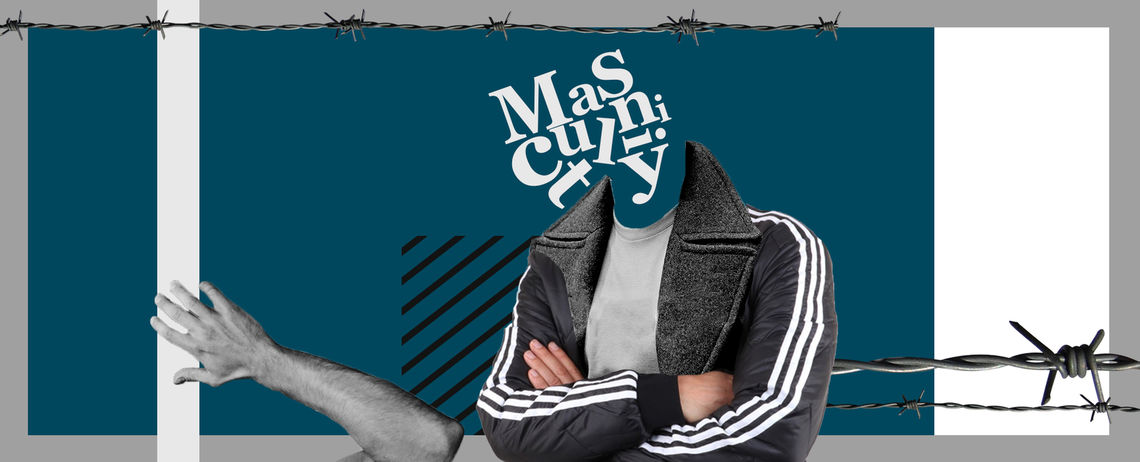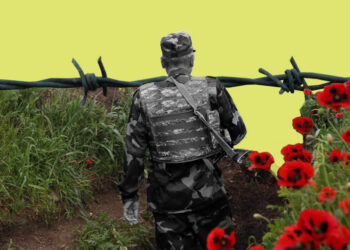

An Armenian man, by his very disposition, must be courageous, a tough guy, bound by honor, a prolific philanderer, an obedient son, a domineering father, a strict husband, and an altruistic friend. He is, in essence, a myth, constructed by his culture, extolled by its values, and in the end, he is doomed to fail. Why? Because he is a walking paradox. In fact, this paradox is superimposed upon him – the stature of Armenian masculinity [1] would have it no other way. He is Atlas, carrying the burden of everyone and everything around him. He is his father’s hope, and most importantly, his mother’s pride and joy. He is spoiled, yet responsible. He is arrogant, yet subtle. He is cruel, yet humane. He is cunning, yet dignified. He is, quite simply, the ideal archetype. And, he is a dying breed.
But this is a slow death, one imposed by a confused society. Instead of killing Armenian masculinity purposely, society is killing Armenian masculinity usefully.[2] The outcome is a deformed masculinity embraced by a nascent subculture, yet one that is slowly becoming mainstream with the younger generation. This deformed masculinity is one where honor is negotiable, dignity is transactional, courage is artificial, and fake toughness the new adage. This is the masculinity of the coward: he yells at his wife in public, but begs and apologizes to her in private; puts labels on the behavior of other women, but ends up marrying the same woman he labelled; pledges loyalty to friends, but in the face of conflict, acts the ostrich; glorifies the criminal [goxakan], but does business with the cop; and yes, boasts his whole life that when he has children he will name them after his parents…only he doesn’t.
This faux masculine deprived of principle, and lacking character, purposefully misconstrues what being a man constitutes. For this reason, it is essential that the record be set straight. Squatting on the street corner, chomping on sunflower seeds and smoking packs of cigarettes is not masculine. Endeavoring to bribe officials because one’s too much of a coward to serve in the military is not masculine. Fancying one’s self a criminal mastermind, but lacking the simple skills to hold a job is not masculine. Being too proud to work, but living off of family and friends is not masculine. And this is precisely what the new “masculine” is, a purveyor of spinelessness, a peddler of hypocrisy that is being molded out of the ashes of a crisis, the crisis of Armenian masculinity. This is the new morality of the emasculated. No wonder he tries to compensate for his lack of manliness by having one goal in life: owning a Mercedes yashik. How can we not speak of a crisis, when pretentiousness has become a virtue?
But why is this the case, and why has it come to this? When culturally-rich, refined masculinity is debased, misunderstood, and denigrated by hypocrisy, a crisis ensues. When dignified manliness is inherited by the undignified, a crisis ensues. When authentic masculinity is too burdensome for the inauthentic, a crisis ensues. It has become too hard to be a real man, thus, the weak are reconstructing what constitutes manliness. The burden and responsibility of genuine masculinity is too much for them, so the new culture of irresponsibility and freeloading must be justified. This is the ethos of the emasculated. And this is where we see the incoherence of modern Armenian “masculinity” – impostors hijacking the narrative of what defines the Armenian male. This new “masculinity,” however, is a reactionary daemon, and when confronted with its deceitfulness and vanity, it morphs into its worst embodiment – cowardice. This is precisely what has developed in much of the Western world, cowardice disguised through insecure masculinity. The outcome is an exaggerated, artificial projection of masculinity – toxic masculinity. Can this faux masculinity of the coward be staved off, or is Armenian masculinity truly doomed? For this, we turn to Mother.
There is a misconception that Armenian masculinity is constructed by the father. In the construction of masculinity, if Armenian society is the structure, the Armenian mother is the agent. The Armenian male, more than anything else, is his mother’s creation. His devotion to her is unequivocal, his adoration of her unmatched. In the Armenian culture, Mother is sacred. By virtue of this sacredness, that which she constructs is venerated by her creation, her son. The construction of Armenian masculinity, then, is two-fold: Mother’s obsession with her son, and the son’s recognition of Mother as institution.
A mother’s obsession over her son is not unique to Armenian culture, but the mother’s construction of his masculine identity, more so than other cultures, is inherent in Armenian Motherhood. The Armenian Mother,[3] herself, is tough, strict, honor-bound, altruistic, and eternally devoted. She is a warrior, emulating her forefathers. She is pure, emulating Mayram Astvacacin (Virgin Mary). She is courageous, defying cowardice. She is anything and everything that her son will idolize. The son’s idolization produces a more powerful effect upon him, and he embraces everything that Mother creates, including his identity, that is, Her construction of his masculinity. Mother’s ontological dominance has no equal. One only needs to look at the statue of Mother Armenia, an awe-inspiring display of masculine veneration.
The Mother’s fixation on her son is not simply biological or natural, it is also cultural and ontological.[4] In the presence of her newborn baby boy, she is delighted to feel needed, she finds justification in responding to his demands, and she fervently embraces maternal love because it requires no reciprocity. This cultural gem, a boy, one that society cherishes and celebrates, is hers and she is extolled for it. He is her victory in a world dominated by men. He has no values, mores, or ideals, he is a blank slate. But she will give them to him, perhaps not fully on her terms, but she will still give them to him and he will love her more than anyone else.
This maternal devotion is initially expressed in perfect authenticity. But as Mother constructs her son’s masculinity, Her maternity becomes a strange compromise of narcissism, selflessness, sincerity, deception, devotion, and cynicism. As society’s agent, she toils and suffers, celebrates and mourns, but nonetheless, produces the final product: Armenian manliness.
Her devotion borders the masochistic. She cultivates a morbid anxiety, giving up all pleasure and all personal life in service to her son. But this is by design, for Mother is enabling Herself to assume the role of victim. All of the sacrifices she has made for her son gives her the right to deny his independence, that is, his ability to construct his own masculinity. She leverages her suffering to exercise her domination: the mater dolorosa (the sorrowful mother) turns her suffering into a weapon. And it works to perfection. After all, what Armenian man can deny his mother’s tears? What Armenian man can deny his mother’s wishes or bear the guilt of breaking her heart? This is inconceivable and antithetical to his manliness; it is anathema to Armenian masculinity.
Her ontological dominance of him, however, is not an act of selfish cynicism, quite the opposite, it is out of authentic love. To the Armenian Mother, her son is a hero, a leader, a creator, someone who will make his mark on society, and she will share in his glories. He is, to Her, a demigod. This demigod that she has created, however, first and foremost, is a demigod by virtue of his manliness. And this is why the construction of his masculinity remains Mother’s ultimate priority, for a demigod can only be one thing: the manliest of men.
To this demigod, Mother represents the divine, she is the architect of all that he values and cherishes. His ego, his pride, his sense of importance are all constructed by Mother. For this demigod, Mother is not mother, that is, she is not female, she is not woman, she has neither gender nor sex. She is to the Armenian male what the Virgin Mary is to Christianity – the Mother, Mother as institution. For every Armenian male, Mother is non-sexual and pure, an ideal that he venerates. Ontologically, every Armenian male presupposes, in fact, wishes, he was immaculately conceived. It is this venerated institution that birthed him. Hence the Mother-worship of the Armenian masculine.
For the longest time, this symbiotic relationship, this ontological bond has been fruitful: the production and reproduction of Armenian masculinity. But as noted earlier, the nascent growth of toxic masculinity seeks to poison not only this bond, but the very foundations of Armenian masculinity. The morality of the emasculated does not value or recognize Mother. It is for this reason that it does not value or respect the feminine. It is a coward, concealing its own insecurity by spewing the poison of misogyny. Toxic masculinity, then, is not only an attack on femininity, it is also an attack on manliness, on the cultural precepts of Armenian society and it is an assault of ontological proportions. Unbeknown to most, it is seeking to dismantle the institution of the Mother. Only by dismantling the creator of real masculinity can the philosophy of the coward reconstruct its own version: toxic masculinity.
In sum, an Armenian man, a real man, that is, the apex of masculinity, is, above and beyond all things, his mother’s creation. And this is the paradox of Armenian masculinity. It is constructed by its opposite, the feminine. Armenian masculinity, over and above the father, is the masterpiece of the materfamilias, the epitome of the feminine in all its purity – the Armenian Mother. It is the Mother’s defiance of the coward that will save Armenian masculinity, and more so, Mother itself, for in the realm of toxic masculinity, Mother becomes mother, she is no longer an institution of reverence. The outcome of this is quite obvious. Without authentic masculinity, Mother is reduced to the irreverent mother, and without Mother, masculinity is reduced to its cowardly alternative. Well, if cowardice breeds toxicity, then it is no wonder that a coward’s mother cannot weep.
*The phrase, a coward’s mother does not weep, is borrowed from the Latin proverb timidi mater non flet.
by the same author
Is the Diaspora Patriotic Enough?
If we are to develop and build a functional relationship between the Homeland and the Armenian Diaspora, we need to understand the discrepancy between the Diaspora’s devotion to Armenianness and the Republic of Armenia’s vision for the Armenian world.
Read moreThe Incoherence of Peace: The Karabakh Quagmire and the Fine Line Between Compromise and Capitulation
While taking the reader through the complexities of international law, Dr. Nerses Kopalyan writes that when Armenia and Azerbaijan speak about peace, they mean completely different things. What they are actually saying is that they seek peace on their own terms.
Read more


